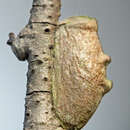en
names in breadcrumbs


The caterpillar of the puss moth, Megalopyge opercularis, also commonly known as the asp caterpillar, is one of the most toxic caterpillars in North America. It is endemic to the southwestern United States and Central America, where it is common, and often found on shade trees such as oaks, elms, maple and citrus, or on small bushes. The 2.5-4 cm long caterpillar is covered with silky yellow, grey, red, or mixed color hairs (setae). Although the caterpillar’s appearance is soft and almost like a small furry cat (possibly inspiring its common name, puss caterpillar) its thick setae hide ridges of short, hollow spines connected to poison glands. When touched, these spines penetrate the skin, injecting poison which causes intense pain, nausea, vomiting, headache and sometimes respiratory distress and stings may require medical attention. Recent molts may also cause a sting. Instead of the usual five prolegs of most caterpillars, those within the flannel moth family (Megalopygidae) have seven. The adult moth, called the Southern flannel moth, is also unusually fuzzy in appearance, with and orange thorax and orange at the base of its blunt yellow wings, a 2.5-4 cm wingspan, and little black furry feet.
(Lyon; Eagleman 2008; Hall 2013; Hyche 1998; Wikipedia 2011)
Megalopyge opercularis occurs only in North and Central America, however in 2013 a megalopygid caterpillar filmed in Amazonian Peru by wildlife photographer Jeff Cremer and conservation biologist Phil Torres was erroneously identified as M. opercularis.Because the Peruvian caterpillar bore resemblance to Donald Trump's hairpiece, news media picked up the story and confusion ciruclates that the common name of M. opercularis is the "Donald Trump" caterpillar.Like M. opercularis, the unidentified caterpillar is in family Megalopygidae, and bears venomous spines that can inflict pain on humans or other animals that brush them, but it is a different species, and perhaps different genus of megalopgid caterpillar.
Megalopyge opercularis is a moth of the family Megalopygidae. It has numerous common names, including southern flannel moth for its adult form, and puss caterpillar, asp, Italian asp, fire caterpillar, woolly slug, opossum bug,[3] puss moth, tree asp, or asp caterpillar.
The inch-long larva is generously coated in long, luxuriant hair-like setae, making it resemble a tiny Persian cat, the characteristic that presumably gave it the name "puss". It is variable in color, from downy grayish white to golden brown to dark charcoal gray. It often has a streak of bright orange running longitudinally. The "fur" on early-stage larvae is sometimes extremely curly, giving them a cottony, puffed-up look. The body tapers to a tail that extends well beyond the body, unlike its relative M. crispata.[4] The middle instar has a more disheveled, "bad-hair-day" appearance, without a distinctive tail. The "fur" of the larva contains venomous spines that cause extremely painful reactions in human skin upon contact. The adult moth is covered in long fur in colors ranging from dull orange to lemon yellow, with hairy legs and fuzzy black feet.
M. opercularis can be found on oak, elm, and wild plum, among others, as well as many garden plants such as roses and ivy. It is distributed throughout the Eastern United States between extreme southeastern Virginia and Florida across the south to Texas, Mexico, and parts of Central America. The caterpillar has 2 broods, one in the summer and the other in the fall. Late larvae may stay in their cocoon all winter, and emerge in late spring as an adult. [5]
The caterpillar is regarded as a dangerous insect because of its venomous spines. Exposure to the caterpillar's fur-like spines leads to an immediate skin irritation characterized by a "grid-like hemorrhagic papular eruption with severe radiating pain." Victims describe the pain as similar to a broken bone or blunt-force trauma,[3] or even white hot.[6] The reactions are sometimes localized to the affected area, but are often very severe, radiating up a limb and causing burning, swelling, nausea, headache, abdominal distress, rashes, blisters, and sometimes chest pain, numbness, or difficulty breathing.[7][8] Sweating from the welts or hives at the site of the sting is not unusual.[9]
The venom from the spines is best treated within hours of first contact. For first aid, the spines (if present) should be removed by using cellophane tape.[7] Some remedies, which are reported to have varying degrees of success, include ice packs, oral antihistamine, baking soda, hydrocortisone cream, juice from the stems of comfrey plants, and calamine lotion.[7]
Megalopyge opercularis is a moth of the family Megalopygidae. It has numerous common names, including southern flannel moth for its adult form, and puss caterpillar, asp, Italian asp, fire caterpillar, woolly slug, opossum bug, puss moth, tree asp, or asp caterpillar.